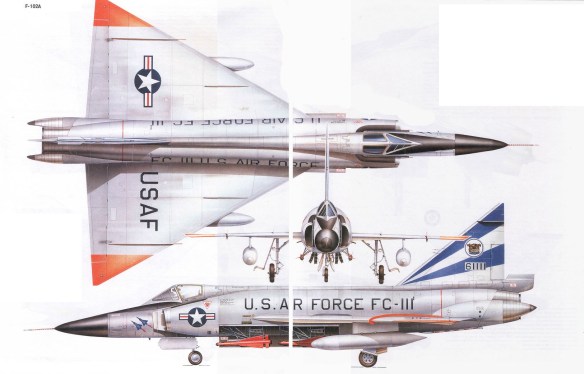
The Delta Dagger was the world’s first supersonic interceptor and the first Air Force jet with a deltawing configuration. It was also unique in being armed only with missiles and rockets, not guns.
In 1950 the Air Force, faced with the specter of Soviet bombers coming over the North Pole, announced a competition to build a supersonic allweather interceptor. Two years earlier, Convair had already tested the XF-92, the world’s first delta-wing jet aircraft, the design offering certain advantages at high speed. In 1954 a scaled-up version, the XF-102, was flown, although it failed to exceed the sound barrier, or Mach 1. Upon further investigation, engineer Richard Whitcomb hit upon the application of “area rule” to reduce drag along the fuselage. Henceforth, the XF-102 was fitted with a pinched waistline, which finally allowed the craft to reach almost 800 miles per hour. The Air Force was impressed, and in 1956 the aircraft went into production as the F-102 Delta Dagger. By 1958 1,100 fighter and trainer craft had been manufactured and deployed.
The F-102 thus became the world’s first delta-wing supersonic interceptor; it was also highly automated. Once airborne, its advanced computers and telemetry would allow ground controllers to direct the craft precisely to an incoming target. When a radar lock was established, the sophisticated fire-control system would unleash numerous guided missiles or a cloud of unguided rockets at the intended target. Because guns were totally dispensed with, all missiles were stored in a weapons bay inside the belly. Ultimately, the Air Defense Command operated a total of 32 squadrons armed with the F-102. They remained in frontline service for two decades before being replaced by the faster McDonnell F101 Voodoo and Convair F106 Delta Dart. The aircraft was also operated in small numbers by Greece and Turkey.
Type: Fighter
Dimensions: wingspan, 38 feet, 1 inch; length, 68 feet, 3 inches; height, 21 feet, 2 inches
Weights: empty, 19,350 pounds; gross, 28,150 pounds
Power plant: 1 × 16,000–pound thrust Pratt & Whitney J57 turbojet engine
Performance: maximum speed, 780 miles per hour; ceiling, 51,800 feet; maximum range, 566 miles
Armament: 6 × Hughes AIM4C radar-guided missiles; 24 × 2.75–inch unguided rockets
Service dates: 1956–1976